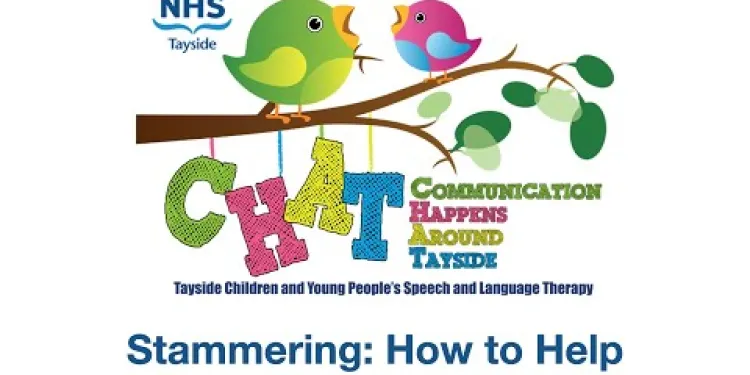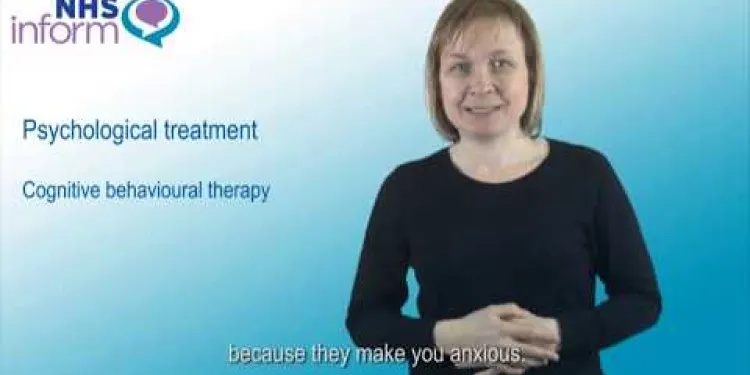Find Help
More Items From Ergsy search
-

Adam's story on stammering - Therapy
Relevance: 100%
-

Will's story on having therapy - Stammering
Relevance: 99%
-

Stammering: myths about the cause of stammering
Relevance: 77%
-

Stammering: How to Help
Relevance: 76%
-

Giving Voice - Stammer and Fluency Problems
Relevance: 72%
-

Stammering myth 4: You should ignore a child's stammer
Relevance: 72%
-

My Stammering Child
Relevance: 71%
-

Why do some children stammer?
Relevance: 69%
-

I don’t need to be fixed – what I wish the world understood about stammering
Relevance: 61%
-

Practical strategies to support young children who stammer
Relevance: 60%
-

What is radiation therapy?
Relevance: 39%
-

Hormone Therapy for prostate cancer
Relevance: 37%
-

Plantar Fascia Cold Therapy
Relevance: 37%
-

What is ketamine infusion therapy?
Relevance: 37%
-

What is antiretroviral therapy (ART)?
Relevance: 36%
-

Is focal therapy an option for prostate cancer?
Relevance: 35%
-

Can therapy help individuals with ADHD?
Relevance: 35%
-

What are some common therapies for autism?
Relevance: 35%
-

Can prostate cancer be treated with targeted therapy?
Relevance: 34%
-

Can Music Therapy Be the Key to Reducing Anxiety?
Relevance: 34%
-

Will I need physical therapy after a hip replacement?
Relevance: 33%
-

Can Paillon treatment be used alongside traditional therapies?
Relevance: 32%
-

How does hormone therapy help in treating prostate cancer?
Relevance: 31%
-

Can physical therapy help whiplash?
Relevance: 28%
-

Charlie and Rupert on their journey with Spinal Muscular Atrophy and Zolgensma Gene Therapy
Relevance: 28%
-

Information for all cancer patients receiving Chemotherapy or Targeted Therapy at HDFT.
Relevance: 27%
-

Talking therapy 'should be offered before pills' for people with insomnia | NHS Behind the Headlines
Relevance: 26%
-

How does PEP therapy work in air physiotherapy?
Relevance: 26%
-

How long is Wegovy therapy typically recommended?
Relevance: 21%
-

How is advanced prostate cancer treated?
Relevance: 12%
-

What are the treatment options for whiplash?
Relevance: 11%
-

Stroke - Speech and Language Therapist's Experience
Relevance: 11%
-

Treating prostate cancer
Relevance: 11%
-

Is there a cure for ADHD?
Relevance: 11%
-

What treatment options are available for bowel cancer?
Relevance: 11%
-

Is CPAP the only treatment for sleep apnea?
Relevance: 11%
-

Is there a cure for motor neurone disease?
Relevance: 11%
-

Treating generalised anxiety disorder (GAD)
Relevance: 11%
-

How is prostate cancer treated?
Relevance: 11%
-

What are common treatments for ADHD?
Relevance: 11%
Adam's Journey with Stammering: Finding Hope and Strength through Therapy
Introduction to Stammering
Stammering, also known as stuttering, is a speech disorder that affects the flow of speech. It involves involuntary repetitions, prolongations, or blocks of sounds, syllables, or words. In the United Kingdom, approximately 1% of the population experiences stammering, impacting both their communication and confidence.
Adam's Struggle with Stammering
Adam, a young man from Manchester, has lived with stammering since childhood. Growing up, he faced several challenges, including bullying and misunderstanding from peers. His stammering not only affected his social interactions but also limited his academic and career opportunities, leading to feelings of isolation and frustration.
Discovering Speech Therapy
Adam's turning point came when he learned about speech and language therapy, a vital tool in managing stammering. After a recommendation from his GP, Adam began sessions with a speech therapist who specialized in stammering. Speech therapy in the UK is often provided by the NHS and private practitioners, offering individuals tailored strategies to improve their speech fluency.
Therapeutic Techniques and Progress
During therapy, Adam was introduced to various techniques designed to enhance his speech fluency and communication confidence. These included controlled breathing exercises, slow speech practice, and gradual exposure to challenging speaking situations. Over time, Adam's speech improved significantly, and he gained new coping mechanisms for moments of disfluency.
Building Confidence and Community Support
A critical aspect of Adam's journey involved building confidence through positive reinforcement and joining support groups. In the UK, organizations such as the British Stammering Association (STAMMA) offer resources and a supportive community for individuals who stammer. These groups provided Adam with a platform to share his experiences, gain encouragement, and inspire others facing similar challenges.
Living Beyond Stammering
Today, Adam continues to make remarkable strides. While stammering remains a part of his life, it no longer defines him. He has successfully pursued a career in public relations, a field once deemed unattainable. Adam's story highlights the profound impact of speech therapy and community support in empowering individuals who stammer to live fulfilling, confident lives.
Conclusion
Adam's story is a testament to the resilience and determination of those living with stammering in the UK. Through the support of speech therapy, community groups, and personal perseverance, individuals like Adam can overcome the challenges of stammering and achieve their goals, fostering a more inclusive and understanding society.
Adam's Journey with Stammering: Finding Hope and Strength through Therapy
What is Stammering?
Stammering, also called stuttering, is when people have trouble speaking smoothly. They may repeat sounds or get stuck on words. About 1 in 100 people in the UK stammer. It can make talking and feeling confident difficult.
Adam's Experience with Stammering
Adam is a young man from Manchester. He has stammered since he was a child. Growing up, this caused problems like being bullied and misunderstood by others. It made making friends and doing well in school or work harder for him. He often felt lonely and upset.
Finding Help in Speech Therapy
Things changed for Adam when he found out about speech therapy. This is a way to help people who stammer. His doctor suggested it, and Adam started seeing a speech therapist. In the UK, the NHS or private therapists can help people learn to speak more smoothly.
Therapy Techniques and Getting Better
In therapy, Adam learned ways to speak more clearly. He practiced breathing exercises, speaking slowly, and facing tough speaking situations. With practice, Adam got better at speaking and felt more sure of himself when talking.
Feeling Confident and Finding Support
Adam also worked on feeling good about himself. He joined groups for people who stammer, like the British Stammering Association (STAMMA). These groups helped him meet others with similar challenges and share stories. This support made him feel inspired and strong.
Living Beyond Stammering
Today, stammering is just one part of Adam’s life. He has a job in public relations, which he once thought was impossible. Adam’s success shows how speech therapy and community support can help people who stammer live happy, confident lives.
Conclusion
Adam's story shows how people with stammering can achieve great things. With help from speech therapy, support from others, and working hard, people like Adam can overcome stammering's challenges. This makes the world more friendly and understanding.
Frequently Asked Questions
What is stammering?
Stammering, also known as stuttering, is a speech disorder characterized by interruptions, repetitions, or prolonged sounds and syllables, affecting the fluency of speech.
How did stammering affect Adam's life?
Adam's stammering affected his self-confidence, social interactions, and academic performance, making everyday communication challenging.
What kind of therapy did Adam receive for his stammering?
Adam received speech therapy, which included techniques such as gentle onset, breathing exercises, and cognitive-behavioural strategies to manage his stammer.
How effective was the therapy for Adam?
The therapy was quite effective for Adam, helping him gain better control over his speech and boosting his self-esteem over time.
What are some common techniques used in speech therapy for stammering?
Common techniques include gentle onset, controlled breathing, prolonged speech, and cognitive-behavioural therapy to address anxiety and negative thought patterns.
Can stammering be completely cured?
Stammering may not be completely cured, but therapy and practice can significantly improve speech fluency and reduce the impact on daily life.
Is stammering hereditary?
Yes, stammering can have a genetic component and may run in families, though environmental factors also play a significant role.
At what age did Adam start receiving therapy for his stammering?
Adam started receiving therapy during his primary school years, which is a common time for children to begin speech therapy.
What support systems helped Adam cope with his stammering?
Adam benefited from family support, understanding teachers, peer support groups, and professional speech therapists.
How can schools support students who stammer?
Schools can support students who stammer by being patient, avoiding putting pressure on them to speak, and providing access to speech therapy services.
What role did Adam's family play in his therapy process?
Adam's family provided emotional support, encouraged him through therapy, and helped create a positive environment for practicing speech techniques.
Are there famous individuals who stammer?
Yes, many famous individuals, such as King George VI and actor Rowan Atkinson, have managed stammering successfully.
What advice does Adam have for others who stammer?
Adam advises others who stammer to seek therapy, practice regularly, remain patient with themselves, and not let the stammer define their self-worth.
Can adults benefit from speech therapy for stammering?
Yes, adults can also benefit from speech therapy, which can help them manage their stammer and improve communication skills.
Where can one find resources and support for stammering in the UK?
Resources and support can be found through organisations like the British Stammering Association (Stamma) and the NHS, which offer information and referrals to speech therapists.
What is stammering?
Stammering means having trouble when trying to talk. It can make words get stuck, or make you repeat sounds. Everyone speaks in their own way, and some people stammer.
If you stammer, here are some ways to help you:
- Take a deep breath before you talk.
- Speak slowly and clearly.
- Practice talking with a friend or family member.
- Use a computer or tablet app that helps with speaking.
- Ask an adult for help if you need it.
Stammering, also called stuttering, is when talking is not smooth. A person might repeat sounds or words, pause a lot, or make sounds longer than usual.
How did stammering change Adam's life?
Adam found it hard to talk because of his stammer.
Here are some ways it changed things for him:
- He felt shy when speaking in front of people.
- He would sometimes get nervous about talking in class or with friends.
- People might not understand him right away, which made him feel sad.
- He avoided saying certain words because they were hard for him.
There are ways to help people who stammer:
- They can work with a speech therapist to practice speaking.
- Using deep breathing can help them stay calm when speaking.
- Friends and family can listen patiently and give encouragement.
With help, Adam can become more confident when talking.
Adam's stutter made it hard for him to feel good about himself. It also made talking to people and schoolwork tough for him. Talking every day was hard.
What help did Adam get to stop stammering?
Adam got help from a speech therapist. This help included special ways to start talking gently, breathing exercises, and thinking techniques to help him with his stammer.
Did the therapy help Adam?
The therapy helped Adam a lot. It made his talking better and made him feel good about himself.
What are some common ways to help with stammering in speech therapy?
Speech therapy can help people who stammer, which means getting stuck on words. Here are some things they might do:
- Slow talking: Practice speaking slowly. This can help make talking easier.
- Breathing exercises: Learn how to breathe in and out while talking. This helps words come out smoothly.
- Practice: Saying words and sentences over and over can help make talking better.
- Feel calm: Learning ways to stay calm can help when speaking feels hard.
- Games and activities: Doing fun things with words can make learning feel fun.
Using these tools can make speaking easier and help people feel better about talking.
Here are some ways to help with talking and feeling better:
- Start speaking gently and slowly.
- Breathe in and out in a calm way.
- Try to make your words longer and smoother when you talk.
- Talk to a helper about your worries and learn to think in a happy way.
Can stammering be completely cured?
Stammering means having trouble speaking smoothly. Some people repeat sounds or pause a lot when they talk.
It is hard to say if stammering can be completely fixed for everyone. Sometimes, it can get better when people get help. They might see a speech therapist. This is a person who helps with speaking.
Here are some ideas to help:
- Practice speaking slowly.
- Take deep breaths before talking.
- Try to stay calm and relaxed.
- Use apps or videos made to help with stammering.
Everyone is different, so some things might help one person but not another. It's important to keep trying different ways to see what helps best.
Stammering might not go away completely, but getting help and practicing can make talking much smoother. It can also make life much easier.
Does stammering run in families?
Some people who stammer have family members who also stammer. This means it might run in families.
If you or someone you know stammers, it can be helpful to talk to a speech therapist. They can give advice and teach you ways to help. You can also practice speaking slowly. This can make talking easier.
Yes, stammering can be passed down in families. This means that if someone in your family stammers, you might too. But things around you, like your environment, also affect stammering.
How old was Adam when he began speech therapy for his stutter?
Tips:
- Break the question into smaller parts.
- Look for key words like "age" and "start".
- Use pictures or diagrams to help understand.
Adam began seeing a helper for talking problems when he was in primary school. Lots of kids get help with talking when they are young.
What helped Adam with his stammering?
Here is a simple question: What helped Adam talk better when he stammered?
Some things helped Adam. Maybe people, tools, or ways to talk.
If you stammer, you can try using helpful tools or talking to understanding people.
- Use a speech app.
- Talk slowly and take your time.
- Practice speaking with someone you trust.
These things might help you too!
Adam got help from his family. His teachers understood him. He also had friends who helped him. Professional speech therapists worked with him too.
How can schools help students who stutter?
Schools can do a lot to help students who stutter. Here are some ways:
- Be patient and listen carefully. Give students time to talk.
- Create a calm classroom. This helps students feel comfortable.
- Encourage all students to be kind and friendly.
- Teachers can learn more about stuttering to offer better support.
- Use tools like pictures and videos to help students communicate.
- Work with speech therapists who know how to help with stuttering.
These steps can help students who stutter feel happier and do well in school.
Schools can help kids who stammer by being patient. Schools should not make them feel they have to talk quickly. Schools can also help by letting kids see a speech therapist.
How did Adam's family help with his therapy?
Adam's family helped him by giving lots of love and cheering him on. They also supported him when he went to therapy. At home, they made things nice and friendly so Adam could practice talking better.
Do famous people stammer?
Yes, some famous people stammer. Here are ways to learn more:
- Watch videos of famous people who stammer. It can help.
- Read stories about them. Stories can inspire you.
- Talk to others who stammer. Sharing helps everyone feel better.
These steps can support and encourage you.
Yes, some well-known people who have had stammers include King George VI and the actor Rowan Atkinson. They have found ways to handle it well.
What tips does Adam have for people who stammer?
Adam gives advice to people who have a stammer. He says it can help to see a therapist. He also says it is good to practice speaking often. Be kind to yourself and don't rush. Remember, you are more than your stammer.
Can grown-ups get help from speech lessons for stuttering?
Yes, grown-ups can get help from speech lessons. These lessons can make talking easier for people who stutter. If you stutter, a speech teacher can show you ways to talk more smoothly.
Here are some things that might help:
- Practice: Talk slowly and think about what you want to say.
- Breathing: Learn how to take deep breaths to calm down.
- Apps: Use phone apps that help you practice speaking.
- Support Groups: Join groups to talk with other people who stutter.
Remember, it's okay to ask for help. Speech lessons can help you feel more confident when talking.
Yes, grown-ups can get help from talking therapy. This can help them with their stammer and make talking easier.
Where can you find help for stammering in the UK?
If you need help with stammering, you can look in different places. Here are some ideas:
- Online Websites: Look for websites that talk about stammering. They can have tips and advice.
- Talking Groups: Join groups where people meet to talk about stammering. You can share stories and help each other.
- Speech Therapists: Find a speech therapist. They can help you learn to speak more easily.
- Charities: Some charities in the UK help people who stammer. You can ask them for advice.
Remember, it’s okay to ask for help. Lots of people want to help you.
You can get help from groups like the British Stammering Association (called Stamma) and the NHS. They give you information and can help you find a speech therapist.
Useful Links
- Ergsy carfully checks the information in the videos we provide here.
- Videos shown by Youtube after a video has completed, have NOT been reviewed by ERGSY.
- To view, click the arrow in centre of video.
- Most of the videos you find here will have subtitles and/or closed captions available.
- You may need to turn these on, and choose your preferred language.
- Go to the video you'd like to watch.
- If closed captions (CC) are available, settings will be visible on the bottom right of the video player.
- To turn on Captions, click settings .
- To turn off Captions, click settings again.
More Items From Ergsy search
-

Adam's story on stammering - Therapy
Relevance: 100%
-

Will's story on having therapy - Stammering
Relevance: 99%
-

Stammering: myths about the cause of stammering
Relevance: 77%
-

Stammering: How to Help
Relevance: 76%
-

Giving Voice - Stammer and Fluency Problems
Relevance: 72%
-

Stammering myth 4: You should ignore a child's stammer
Relevance: 72%
-

My Stammering Child
Relevance: 71%
-

Why do some children stammer?
Relevance: 69%
-

I don’t need to be fixed – what I wish the world understood about stammering
Relevance: 61%
-

Practical strategies to support young children who stammer
Relevance: 60%
-

What is radiation therapy?
Relevance: 39%
-

Hormone Therapy for prostate cancer
Relevance: 37%
-

Plantar Fascia Cold Therapy
Relevance: 37%
-

What is ketamine infusion therapy?
Relevance: 37%
-

What is antiretroviral therapy (ART)?
Relevance: 36%
-

Is focal therapy an option for prostate cancer?
Relevance: 35%
-

Can therapy help individuals with ADHD?
Relevance: 35%
-

What are some common therapies for autism?
Relevance: 35%
-

Can prostate cancer be treated with targeted therapy?
Relevance: 34%
-

Can Music Therapy Be the Key to Reducing Anxiety?
Relevance: 34%
-

Will I need physical therapy after a hip replacement?
Relevance: 33%
-

Can Paillon treatment be used alongside traditional therapies?
Relevance: 32%
-

How does hormone therapy help in treating prostate cancer?
Relevance: 31%
-

Can physical therapy help whiplash?
Relevance: 28%
-

Charlie and Rupert on their journey with Spinal Muscular Atrophy and Zolgensma Gene Therapy
Relevance: 28%
-

Information for all cancer patients receiving Chemotherapy or Targeted Therapy at HDFT.
Relevance: 27%
-

Talking therapy 'should be offered before pills' for people with insomnia | NHS Behind the Headlines
Relevance: 26%
-

How does PEP therapy work in air physiotherapy?
Relevance: 26%
-

How long is Wegovy therapy typically recommended?
Relevance: 21%
-

How is advanced prostate cancer treated?
Relevance: 12%
-

What are the treatment options for whiplash?
Relevance: 11%
-

Stroke - Speech and Language Therapist's Experience
Relevance: 11%
-

Treating prostate cancer
Relevance: 11%
-

Is there a cure for ADHD?
Relevance: 11%
-

What treatment options are available for bowel cancer?
Relevance: 11%
-

Is CPAP the only treatment for sleep apnea?
Relevance: 11%
-

Is there a cure for motor neurone disease?
Relevance: 11%
-

Treating generalised anxiety disorder (GAD)
Relevance: 11%
-

How is prostate cancer treated?
Relevance: 11%
-

What are common treatments for ADHD?
Relevance: 11%


